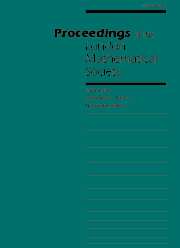Local Tame Lifting for GL(n) IV: Simple Characters and Base Change
Published online by Cambridge University Press: 26 September 2003
Abstract
Let $F$ be a $p$-adic field and $K/F$ a finite, cyclic, tamely ramified field extension. We show, without any restriction, that base change from $F$ to K, in the sense of Arthur and Clozel, is compatible with the operation of $K/F$-lifting for simple characters defined by the authors in an earlier paper. This extends and completes the previous work, and represents a substantial step towards the goal of describing tamely ramified base change in terms of the structure theory of representations of Bushnell and Kutzko. We also give a consequence for the Langlands correspondence. The main step in the proof is to show that lifting of simple characters is compatible with automorphic induction, in the sense of Henniart and Herb, through an unramified extension. This is achieved via a new and independently interesting result concerning the conductor of a pair of supercuspidal representations. It gives a complete description of the minima of (a suitably normalized version of) the conductor when one of the representations is fixed. All results concerning the conductor are also valid for non-Archimedean local fields of positive characteristic.
Keywords
- Type
- Research Article
- Information
- Proceedings of the London Mathematical Society , Volume 87 , Issue 2 , September 2003 , pp. 337 - 362
- Copyright
- 2003 London Mathematical Society
Footnotes
- 15
- Cited by


